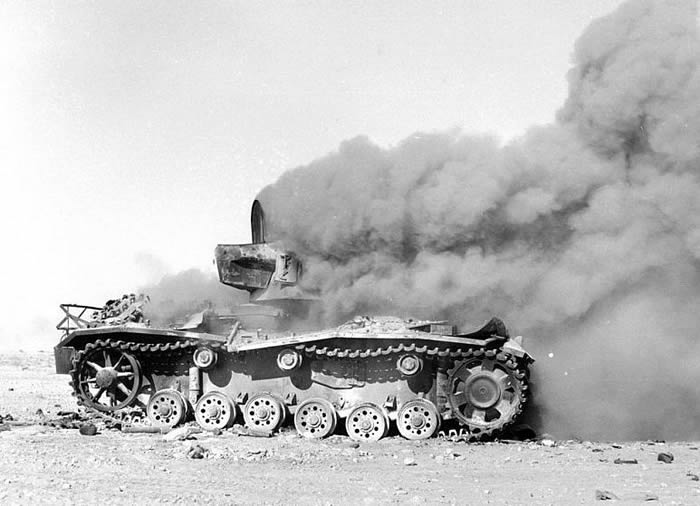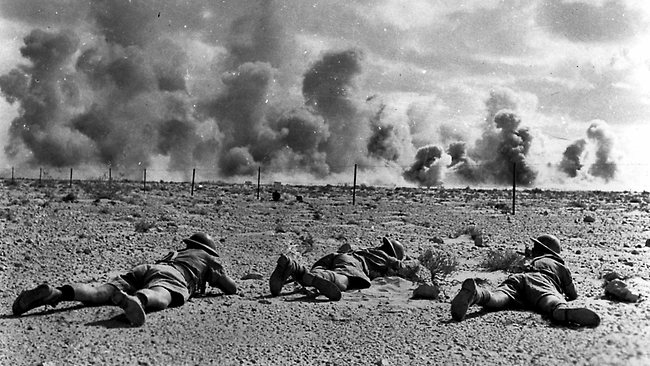 |
| British defence in El Alamein |
El Alamein is railway station west of the Egyptian port of Alexandria where a series of three battles were fought in 1942. The result was the end of German and Italian aspirations of conquering Egypt and advancing into the Middle East. El Alamein was one of the most decisive battles of World War II not only because of its strategic results but also because of how it altered perceptions about who could win the war.
In 1940 Libya was an Italian colony that bordered on Egypt, where British troops were stationed in force. When the Italians joined the war in June 1940 on Germany's side, they expected that they would be able to attack France and gain some quick and easy concessions. They did not expect that the British, outnumbered by the Italians, would attack.
Yet under the direction of Generals O'Connor and Wavell, that is exactly what they did. The British captured the port city of Benghazi. They were well on their way toward capturing all of Libya when they were counterattacked by the Germans, reinforcing the Italians.
  |
The Germans took the city of Benghazi back from the British and then advanced to Egypt and the Suez Canal. The German commander Erwin Rommel next attacked the city of Tobruk, was in turn attacked by the British, and was forced to retreat. The British managed to force him back deep into Libya.
In the next year Rommel counterattacked, retaking Benghazi and capturing Tobruk. From there he again advanced and crossed the border into Egypt. He was stopped at the First Battle of El Alamein in July 1942. Both sides waited for a time.
The British solidified their positions, while Rommel gathered his increasingly small amount of supplies, including fuel for his vehicles. In the first week of September, Rommel felt he had to attack and so launched an assault on the British positions at a place called Alam Halfa in what became known as the Second Battle of El Alamein.
 |
| German panzer destroyed |
Repulsed by the British, Rommel now began efforts to fortify his positions, creating obstacles through the use of minefields. He had no realistic expectation of attacking again and so had to remain in place. Although he had advanced so far into Egypt, the situation now favored the British.
The troops under the British commander Montgomery outnumbered Rommel's nearly two to one and had at least twice as many tanks. In all aspects the British supply situation was much better. Rommel had so little fuel that his ability to move was severely limited. At the same time, the British gasoline was more plentiful than water.
That logistical superiority was to translate into immense tactical superiority on the night of October 23, 1942. That night the British opened with a massive artillery barrage using over 600 guns.
   |
This extensive artillery preparation lasted several hours and moved its focal point up and down the German line. Then it moved forward to allow the combat engineers with supporting tanks to disarm the extensive minefields that formed the backbone of Rommel's defenses.
The process of attacking by the 8th British Army was slow and methodical and would concentrate first on one part of the German line and then on another. Montgomery referred to this process as "crumbling" the enemy's defenses.
The Germans counterattacked but failed in their attempt to drive the British back. Finally, on November 2 the British broke through the last belt of minefields, and the attack could begin. By November 4 Rommel decided to retreat to the west.
 |
| Australian troops crawling along the ground |
From the west, in French North Africa, the Americans landed an army of over 400,000 men, who advanced eastward. Caught between the British and the Americans, Rommel's army surrendered in Tunisia in May 1943. The war in Africa was over.
At El Alamein Rommel was at his farthest point from his base of supplies. He had one route that followed the coastline; everything had to come to him that way from the Italians in Libya. Their bases were supplied by ship from Italy. This supply route was under constant attack by British submarines and aircraft.
Italian and German ships were sunk, and much of what was supposed to go to Rommel never reached him. Supply superiority translated into tangible benefits: more tanks and cannon as well as massive air superiority. That also translated into intangibles such as better morale helped by ample stores of food and other supplies.
If the British had lost at El Alamein, they could have lost all of Egypt, which would have been catastrophic. The Germans had hoped to link up with their soldiers in Russia by this route. The Germans could have captured the Suez Canal and controlled the Mediterranean. A push further would have brought them into Palestine.
There was no oil there, but a pipeline from Iraq built in the 1930s would have given them access to it. Considering that the government in Iraq was pro-Nazi, that would have solved Germany's oil problems. Further, the loss would have damaged British prestige and credibility.